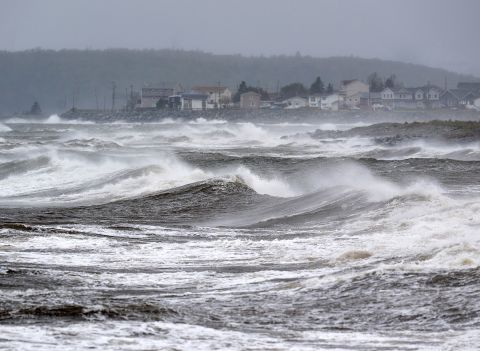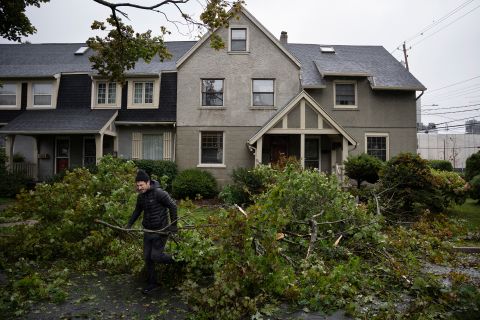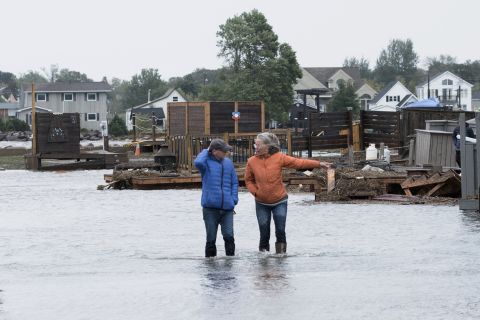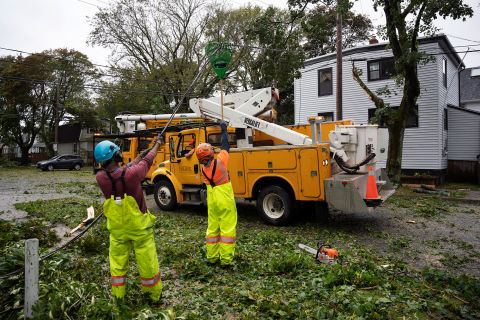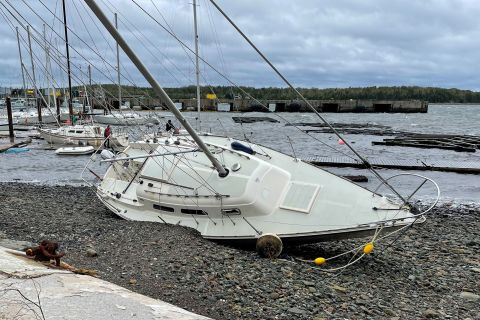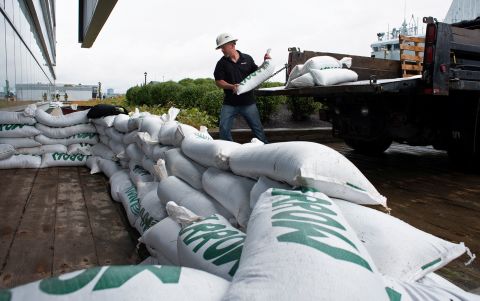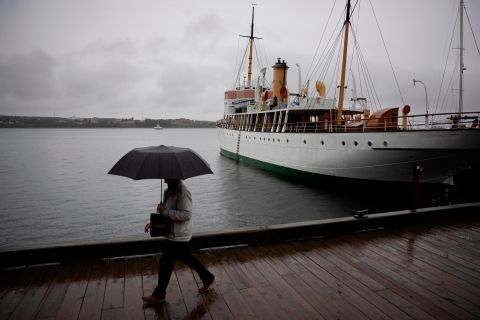
Editor’s Note: Affected by the storm? Use CNN’s lite site for low bandwidth.
CNN
—
Fiona ripped through Canada’s eastern seaboard at hurricane strength after making landfall in Nova Scotia on Saturday, slamming the area with fierce winds and storm surge, sapping power for hundreds of thousands and washing away or collapsing some coastal homes.
Fiona, now a post-tropical cyclone, had maximum sustained winds of 70 mph as it continued to slowly weaken Saturday evening, according to the US National Hurricane Center. But Canadian officials warned it remains a dangerous storm and the threats are not yet over.
Its center was about 80 miles northwest of the coastal town of Channel-Port aux Basques, in Newfoundland and Labrador, where the storm left a trail of devastation. Some coastal homes in the area collapsed and a few toppled structures fell into the sea or were surrounded by floodwater, pictures sent from the province Saturday morning showed.
In Channel-Port aux Basques, houses were washed away, Mayor Brian Button said in a Facebook video Saturday morning. Dangerous storm surges – ocean water pushed onto land – were expected in parts of Atlantic Canada, accompanied by “large and destructive waves,” forecasters said Saturday.
Authorities in the province declared a state of emergency for the town amid “multiple electrical fires, residential flooding and washouts” Saturday morning.
René Roy, editor-in-chief of Wreckhouse Press, a local news publication, described a scene of carnage in the storm: uprooted trees, at least eight nearby homes vanished in the wake of a violent storm surge, cabins floating by, a boat carried by floodwaters into the middle of a local playground.
“I’ve lived through Hurricane Juan and that was a foggy day compared to this monster,” Roy, 50, told CNN. Hurricane Juan battered the Canadian coast as a Category 2 storm in 2003, knocking down power lines and trees and leaving behind extensive damage. “It is surreal what is happening here,” Roy added.
Roy told CNN he evacuated from his home and staying with a cousin on higher ground. He has no idea if his home is still standing and emergency personnel stopped him from driving over to check. It was unsafe to do so, they warned.
Pictures by another area resident, Terry Osmond, showed a collapsed building in Channel-Port aux Basques surrounded by seawater at the shoreline, and splintered wood and other debris were scattered across town.
“Never in my lifetime” has there been “so much destruction … in our area,” Osmond, 62, wrote to CNN.
A woman in town was rescued from water Saturday afternoon after her home collapsed, the Royal Canadian Mounted Police said. She was taken to a hospital; the extent of her injuries wasn’t immediately known, police said.
About a 30-minute drive to the east, several buildings were blown apart In the coastal Newfoundland community of Burnt Islands, video posted to Facebook by Pius Scott showed. Homes – or parts of them – collapsed in heaps, and debris littered the ground and seawater.
Canadian Prime Minister Justin Trudeau said in a Saturday afternoon news conference the government was assessing damage from the storm but officials had already begun helping communities who were affected, including approving Nova Scotia’s request for federal assistance. The Canadian Armed Forces will also be deployed to the region to assist in damage assessment and cleanup, Trudeau said.
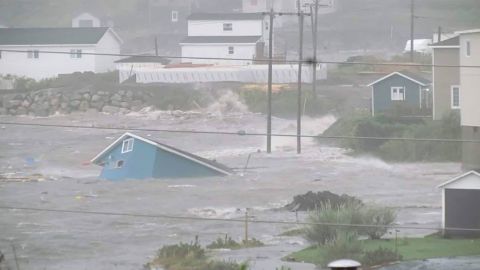
Meanwhile, power outages were reported for nearly half a million utility customers in Atlantic Canada by Saturday evening, including more than 339,000 in Nova Scotia and more than 84,000 on Prince Edward Island, according to Poweroutage.com.
Restoring power was among officials’ biggest priorities, Nova Scotia Premier Tim Houston said during a Saturday news conference, describing “shocking” damage across the province, including communities whose roads had been washed out and littered with downed trees and power lines.
But weather conditions were still too severe in many areas for crews to begin assessing and repairing damage, said Nova Scotia Power President and CEO Peter Gregg. More than 900 power technicians are on their way to the area, but with parts of the province still experiencing storm conditions, Gregg added some customers may experience power outages for several days.
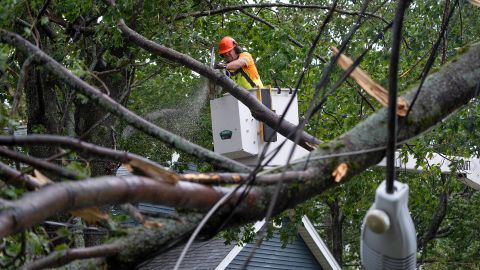
The storm made landfall in the darkness of early Saturday as a powerful post-tropical cyclone in eastern Nova Scotia, between Canso and Guysborough, and crossed over the province’s Cape Breton Island. Officials in the Cape Breton area declared an emergency and asked people to shelter in place.
The Cape Breton Regional Municipality wrote on Twitter Saturday afternoon telecommunications systems were making it difficult for officials to receive information ad urged residents to remain sheltered and not to travel.
“There are more than 70 road closures and hazards,” it warned.
West of landfall, in Nova Scotia’s capital, Halifax, an apartment complex’s roof collapsed, forcing about 100 people to leave for a shelter, Mayor Mike Savage told CNN Saturday.
“The magnitude of this storm has been breathtaking,” Savage later said in Saturday’s news conference. “It turned out to be everything predicted.”
Officials in Halifax said Saturday afternoon strong winds and risks of coastal flooding remained for the rest of the day and urged residents to stay off the roads while cleanup efforts were underway.
In the Prince Edward Island capital of Charlottetown, police tweeted photos of damage including a home’s collapsed ceiling.
“Conditions are like nothing we’ve ever seen,” Charlottetown police tweeted early Saturday.
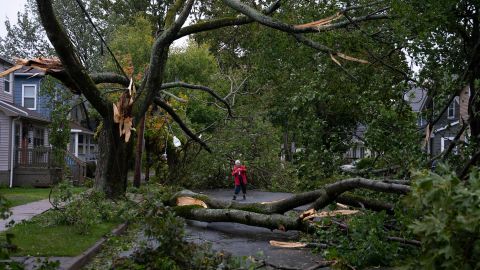
On its forecast track, Fiona’s center was expected to move across Labrador and over the Labrador Sea late Saturday and Sunday, the hurricane center said.
Large swells generated by Fiona which could cause “life-threatening surf and rip current conditions” were affecting Atlantic Canada, the northeastern US coast, and Bermuda Saturday evening, the center added.
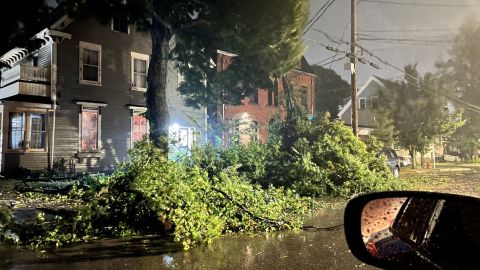
Gale-force and storm-force winds were expected to continue blowing through parts of Atlantic Canada through early Sunday, the center said.
Saturday morning, hurricane-force gusts were reported across parts of Maritime Canada, generally ranging from 70 to 95 mph (110 to more than 150 kph). A top gust as of midmorning was 111 mph (179 kph) in Arisaig, Nova Scotia, according to Environment Canada.
Rainfall could total up to 10 inches in some places, and significant flooding is possible, forecasters said.
The storm already claimed the lives of at least five people and shut off power for millions as it battered islands in the Caribbean and the Atlantic earlier this week.
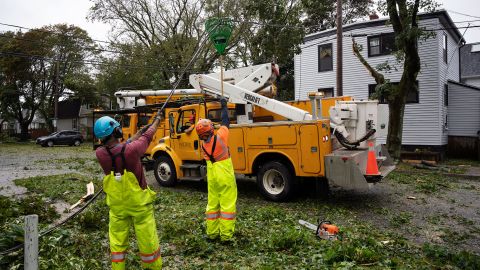
Fiona had been a Category 4 storm early Wednesday over the Atlantic after passing the Turks and Caicos and remained so until Friday afternoon, when it weakened on approach to Canada. It became post-tropical before making landfall, meaning instead of a warm core, the storm now had a cold core. It does not affect the storm’s ability to produce intense winds, rain and storm surge, it just means the storm’s interior mechanics have changed.
Fiona had the potential to become Canada’s version of Superstorm Sandy, Chris Fogarty, Canadian Hurricane Centre manager, said before Fiona hit. Sandy in 2012 affected 24 states and all of the eastern seaboard, causing an estimated $78.7 billion in damage.
An unofficial barometric pressure of 931.6 mb was recorded Saturday at Hart Island, which would make Fiona the lowest pressure landfalling storm on record in Canada, according to the Canadian Hurricane Centre.

